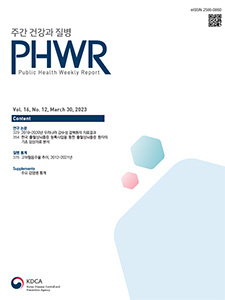Current Issue
Vol.16 No.12, March 30, 2023
-
Original Articles 2023-03-30
 4
4
 1233
1233
 278
278
Treatment Outcomes among Drug-susceptible Patients with Tuberculosis in the Republic of Korea, 2019–2020
Jaetae Kim, Jiyeon Han, Yunhyung Kwon*, Hoyong Choi
Public Health Weekly Report 2023; 16(12): 329-353 https://doi.org/10.56786/PHWR.2023.16.12.1 Abstract
AbstractThe number of patients with tuberculosis (TB) in the Republic of Korea (ROK) has decreased by 7.4% on average each year over the past decade since reaching its peak in 2011 (39,557 cases) and declined to more than 50% in 2021. To continue reducing the number of patients with TB, an improvement in the TB treatment success rate ( TSR) is required. The World Health Organization considers the “ TB TSR” as a significant indicator for TB control, with a target reaching at least “90%.” In ROK, the TSR and mortality rate among all patients with TB was 80.1% and 14.8% in 2020 and decreased by 1.8% and increased by 1.7%, respectively, compared with the rates in 2019. The TB TSR among aged 65 years and older was the lowest at 70.8% (extra-pulmonary TB, 82.6%; smear-negative pulmonary TB, 81.6%; and smear-positive pulmonary TB, 74.7%). The TSR was 6.1% higher in new patients (81.3%) than that in previously treated patients (75.2%), and the treatment interruption rate was two times higher in previously treated patients (3.6%) than in new patients (1.8%). Various efforts are necessary to improve the TSR not only by investigating the cause of death but also developing relevant policies and projects to support vulnerable patients that target groups with have a relatively low TSR, including smear-positive and previously treated patients.
-
Original Articles 2023-03-30
 0
0
 1688
1688
 336
336
An Analysis of Basic Clinical Data on Hemorrhagic Stroke Patients Using the Korean Hemorrhagic Stroke Registry
Won Joo Lee, Soon Chan Kwon, Dongkeun HYUN, Hyon-Jo Kwon
Public Health Weekly Report 2023; 16(12): 354-375 https://doi.org/10.56786/PHWR.2023.16.12.2 Abstract
AbstractStroke is a major cause of death and disability in Korea and given its aging population, stroke incidence cases are expected to continue to increase. In particular, hemorrhagic stroke is a highly severe type of strokes with poor prognosis. Therefore, it is necessary to build the multi-center registry system to accumulate data on clinical and epidemiological characteristics of various hemorrhagic stroke patients and based on the accumulated data to do researches on it. This study made into database the clinical data on 457 hemorrhagic stroke patients of three Korean university hospitals (Regional Cardiocerebrovascular Centers) included in the Korean Hemorrhagic Stroke Registry from September 1, 2021 to July 31, 2022 and analyzed the data. The mean age of patients in the registry was 62.8 years old, with males being 51.4%. Among them, the largest proportion of hemorrhagic stroke was taken up by intracerebral hemorrhage (68.9%), followed by subarachnoid hemorrhage (26.1%) and intraventricular hemorrhage (5.0%). 61.7% of patients arrived within 3 hours of onset, and 81.4% of patients were carried to hospital by ambulance. Arriving at hospital, 49.2% of patients were under stupor or worse. The most prevalent risk factor for hemorrhagic stroke was high blood pressure (50.5%), followed by alcohol (37.6%) and smoking (24.3%). The mean rate of expired at hospital was 13.6%, with that of subarachnoid hemorrhage being the highest (18.5%). This study expects that there will be further long-term follow-up studies in the future that will contribute to creating the guidelines for hemorrhagic stroke and establishing national public health policies.
-
QuickStats 2023-03-30
 4
4
 1206
1206
 176
176
Trends in the Prevalence of High-Risk Drinking, During 2012-2021
Public Health Weekly Report 2023; 16(12): 376-377 https://doi.org/10.56786/PHWR.2023.16.12.3

pp. 1433~1461
Most Keyword
?
What is Most Keyword?
- It is the most frequently used keyword in articles in this journal for the past two years.
Most Read
-
Waterborne and Foodborne Disease Outbreaks in the Republic of Korea, 2023
Myung-Jae Hwang, So Yeon Park, Hyungjun Kim, Se Jeong Yang, Sungchan Yang, Jin Seon Yang
Public Health Weekly Report 2025;18: 17-32 https://doi.org/10.56786/PHWR.2025.18.1.2 -
Implementation Plan for the Coronavirus Disease 2019 Vaccination for the 2024–2025 Season: Recommendations of the 6th Expert Committee on Immunization Practices
Hyewook Hwang, Wookeon Lee, Seohyeon Ahn, Young-Sook Choi, Seunghyun Lewis Kwon, Dongwoo Lee, Eun Hwa Choi, SokGoo Lee
Public Health Weekly Report 2025;18: 90-102 https://doi.org/10.56786/PHWR.2025.18.2.3
Editorial Office
+82-43-719-7569





 Full Text
Full Text Cite
Cite


